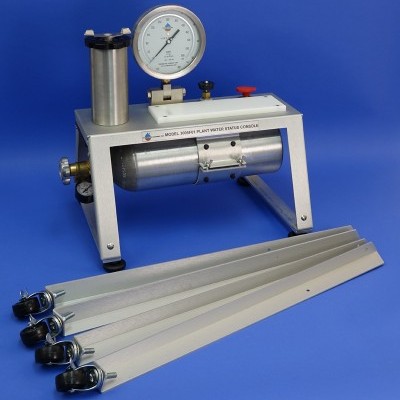
Our list of current Plant physiology products are listed below. If you cannot find what you are looking for, please contact us and we will try our best to help you.

12 inch Pressure Vessel, G4 Specimen Holder, 40 bar Gauge. Tension in plant xylem can be measured using a plant water status console device. The petiole of a leaf or stem is placed in a rubber grommet so the leaves are inside the pressure chamber and the stem is outside at atmospheric pressure. By pressurizing the chamber and watching the point where the sap oozes out of the stem at atmospheric pressure the two forces are in balance. ...

The Plant Water Status Console is supplied with a compressed gas cylinder and connected to a pressure regulator for field operation. The pressure regulator has been set at the factory for the maximum operation pressure of the unit which, for standard units, is 600 psi. ...
• Enables non-destructive measurements.
• Lightweight and fully portable.
• No calibration required.
• 32 K internal memory.
• Rechargeable battery.The portable leaf area matter enables samples to be measured without detaching them from the plant. The unit is operated using only two buttons to select options from the display. Individual readings can be stored, or areas can be accumulated as a running total.The unit is supplied with an RS232 cable and IBM compatible software. This enables data to be transferred to a computer for further analysis if required.A full range of parameters can be measured including leaf area, width, perimeter length, shape factor and ratio. The sensitivity of the scanner can be adjusted so that healthy or diseased parts of the leaf can be recorded. This flexibility makes the instrument ideal for the field scientist investigating the effects of pollution on plants. The leaves do not have to be removed for measurement so the same plant can be monitored over a period of time in detailed experiments. ...

Accurate and reliable results Non-destructive Lightweight, hand-held design Storage of 160,000 data sets This instrument has been designed to accuractely determine the chlorophyll content in plants and crops. Especially useful for improving Nitrogen management programs and is ideal for research and teaching. The ample on-board data storage and hand-held design makes this meter the most field efficient chlorophyll content meter on the market. ...

• Direct readout of conductance or resistance.
• Simple field calibration.
• Stores up to 1500 readings.
• Leaf stress minimised during measurements.When the sensor head is clipped onto a leaf, a small cup is gently pressed onto the leaf surface. Water vapour diffuses out of the leaf via the stomata and this raises the humidity in the cup. The instrument times the raise in humidity between two electronically preset levels. This RH transit time is a measure of water vapour loss and is automatically converted into diffusion resistance or conductivity. Calibration should be carried out at the start of each session and when environmental conditions change significantly. A polypropylene plate with 6 groups of precisely moulded holes is used to simulate a leaf. The diffusion resistance of each group is known from the physical dimensions of the holes. The instrument is calibrated using these values, and will also give a warning if changing conditions require recalibration. ...

• Lightweight, compact, portable field instrument.
• No moving parts for reliable operation.
• State-of-the-art microprocessor and logic control.
• Fast accurate measurement and calculations.
• PC link and analysis software included.When lights shines on a plant it is absorbed by the chlorophyll molecules in the leaf. The absorbed energy is then utilised in a variety of ways including photosynthesis, the process by which carbon dioxide in the atmosphere is converted by the plant to organic compounds. A proportion of the absorbed energy is re-emitted as chlorophyll fluorescence.The Plant Efficiency Analyser measures this fluorescence and calculates key parameters to provide a direct measurement of photochemical efficiency and thus indicate stress conditions at an early stage.Many factors may influence the wellbeing of plants including the temperature and light conditions, shortage of water or nutrients, contaminated soil, air pollution and acid rain. All of these have an effect on chlorophyll fluorescence making this an ideal instrument for the serious study of plant health, crop selection or plant breeding. ...


Includes electronic components, pump, cables and fuses. ...